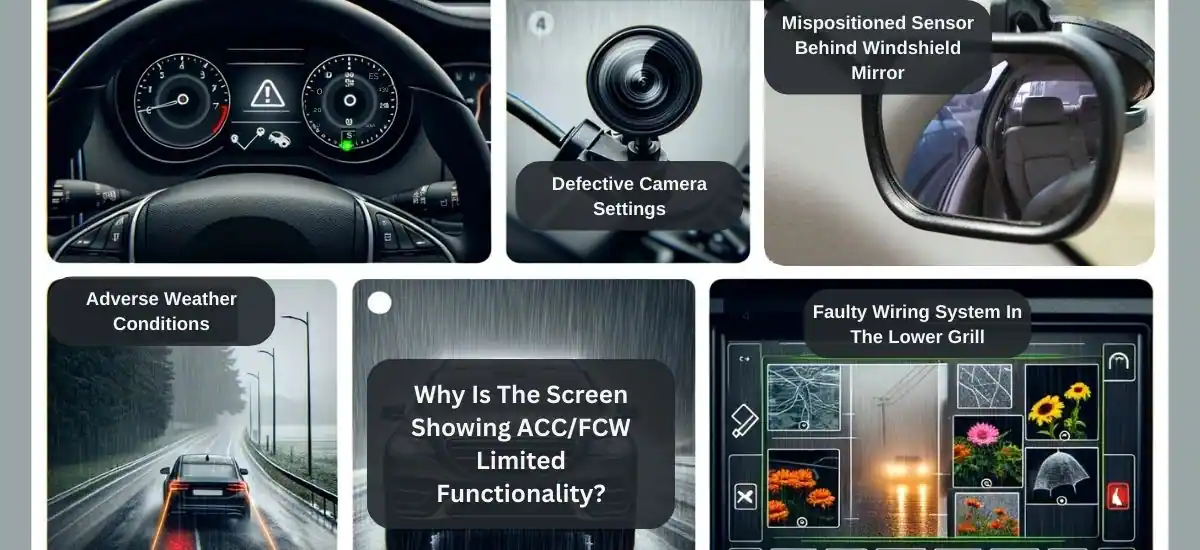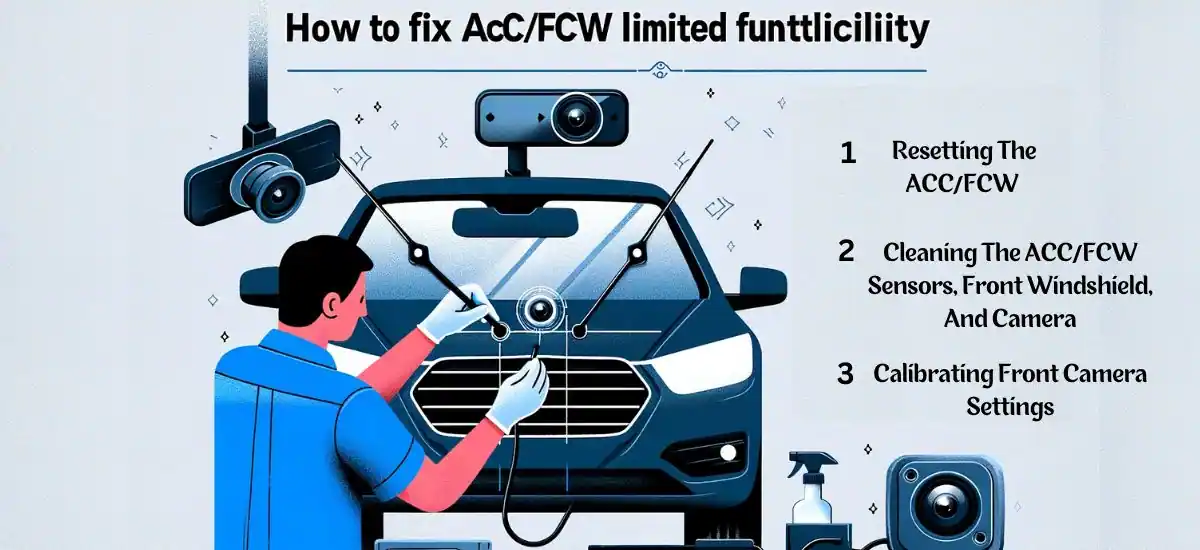Imagine driving on a serene morning, and suddenly, your car’s screen displays a message that reads, “ACC FCW Limited Functionality, Service Required”. It’s alarming, isn’t it? But don’t fret; we’re here to guide you through the process of understanding and rectifying this issue.
How Concerning Is The ACC/FCW Limited Functionality?
For seasoned drivers, the ACC/FCW limited functionality might not be a significant concern. However, for those who heavily rely on these features for safety, it’s a different story. Just as a malfunctioning brake light can lead to potential hazards, a non-functional ACC or FCW can compromise road safety.
Check On: What Does A Bad Spark Plug Look Like
Why Is The Screen Showing ACC/FCW Limited Functionality?

The ACC (Adaptive Cruise Control) and FCW (Forward Collision Warning) systems are integral components of modern vehicles, designed to enhance driving safety. However, when the screen displays the “ACC/FCW Limited Functionality” message, it indicates that there’s an issue preventing these systems from operating optimally.
Let’s delve into the potential reasons:
1. Mispositioned Sensor Behind Windshield Mirror
Conclusion: Proper sensor alignment is crucial for accurate readings.
- The ACC/FCW system heavily relies on sensors to detect obstacles and other vehicles.
- If the sensor behind the windshield mirror is mispositioned, it may not capture accurate data.
- Common causes for mispositioning include recent windshield replacements or accidents that might have shifted the sensor’s alignment.
- A misaligned sensor can lead to false readings or even a complete system shutdown, prompting the “ACC/FCW Limited Functionality” message.
2. Adverse Weather Conditions
Conclusion: External elements can obstruct sensor functionality.
- Sensors and cameras are designed to detect objects under normal conditions. However, they can be compromised under adverse weather conditions.
- Heavy snow, ice, fog, or even thick mud can obstruct the sensors, preventing them from capturing accurate data.
- For instance, a layer of snow or ice on the sensors can block their field of view, leading to malfunction.
3. Faulty Wiring System In The Lower Grill
Conclusion: Proper wiring ensures uninterrupted system communication.
- The wiring system connects the sensors and cameras to the vehicle’s main computer.
- Any fault in this wiring, especially in vulnerable areas like the lower grill, can disrupt this communication.
- Issues like frayed wires, loose connections, or short circuits can lead to intermittent functionality or even a complete system failure.
4. Defective Camera Settings
Conclusion: Camera calibration is essential for accurate object detection.
- Many ACC/FCW systems use cameras to detect vehicles and obstacles.
- If these cameras are not calibrated correctly or their settings are off, they might not function as intended.
- A camera that isn’t capturing accurate visuals can lead to false warnings or even fail to detect real threats, compromising the system’s efficacy.
How To Fix The ACC/FCW Limited Functionality?
Before you rush to the mechanic, consider these DIY fixes:
Step 1: Resetting The ACC/FCW
Sometimes, electronic glitches can cause the ACC/FCW system to malfunction. A simple reset can often resolve these minor issues. Here’s how to do it:
- Disconnect the battery: Start by turning off the vehicle. Open the hood and locate the battery. Using a wrench, disconnect the negative terminal (usually black or marked with a ‘-‘) followed by the positive terminal.
- Wait for 15 minutes: This waiting period ensures that any residual power in the vehicle’s electrical system is drained, effectively resetting the system.
- Reconnect the battery: First, connect the positive terminal and then the negative terminal. Ensure the connections are tight and secure.
Step 2: Cleaning The ACC/FCW Sensors, Front Windshield, And Camera
Dirt, debris, or other obstructions can interfere with the sensors and camera’s ability to function correctly.
⚠️ Warning: Ensure you use appropriate cleaning agents to avoid damaging the sensors or camera.
- A clean sensor is a happy sensor: Locate the ACC/FCW sensors on your vehicle. They are typically found on the front grille or behind the windshield.
- Use appropriate cleaning agents to wipe off any obstructions: Gently clean the sensors using a soft cloth dampened with a suitable cleaning agent. For the windshield and camera, use a glass cleaner. Avoid abrasive materials or chemicals that might scratch or damage the sensors.
Step 3: Calibrating Front Camera Settings
The front camera plays a crucial role in the ACC/FCW system by detecting obstacles and other vehicles.
- Ensure your front camera is correctly calibrated: Over time, the camera’s settings might drift or become misaligned, especially after events like a minor collision.
- If not, adjust its settings: Refer to your vehicle’s manual for calibration instructions. Some modern vehicles offer a user-friendly interface on the dashboard for calibration, while others might require specialized equipment or a visit to the dealership.
ACC/FCW Limited Functionality In Different Brands

| Brand | Reason |
| Jeep Cherokee | Often due to camera alignment issues. |
| Maserati | Dirty sensors and cameras are usually the culprits. |
| Alfa Romeo Stelvio | A dirty windscreen or a misaligned camera can trigger the message. |
| Chrysler Pacifica | Internal malfunctions might be the root cause. |
| Dodge Durango | Misplaced windshield sensors can be the problem. |
Frequently Asked Questions
Q1. How often should I service or check the ACC/FCW systems?
Ans. It’s recommended to have these systems checked during your regular vehicle maintenance or at least once a year. However, if you notice any irregularities or receive warning messages, consult your mechanic immediately.
Q2. Can I manually turn off the ACC/FCW systems?
Ans. Yes, most vehicles allow you to manually deactivate these systems through the vehicle’s settings or dashboard controls. Refer to your vehicle’s manual for specific instructions.
Q3. Are ACC and FCW standard in all modern vehicles?
Ans. While these systems are becoming increasingly common in newer models, they are not standard in all vehicles. They are often part of advanced safety packages or higher-end trim levels.
Q4. How reliable are the ACC and FCW systems in real-world scenarios?
Ans. While these systems are designed to enhance safety, they are not infallible. They should be used as supplementary safety features and not as a replacement for attentive driving.
Q5. How To Test A Battery With A Multimeter?
Ans. To test a battery with a multimeter, set the multimeter to the DC voltage setting. Connect the red probe to the positive terminal and the black probe to the negative terminal. A reading within the battery’s rated voltage indicates it’s in good condition. A significantly lower reading suggests the battery might be dying.
Q6. How Is Catalytic Converter Scrap Price Determined?
Ans. The scrap price of a catalytic converter is determined by several factors, including the precious metals it contains (like platinum, palladium, and rhodium), the overall condition of the unit, and current market demand and prices for these metals.
Q7. What Does A Bad Spark Plug Look Like
Ans. A bad spark plug may have a worn or damaged electrode, deposits or fouling on the insulator, cracks or chips in the ceramic insulator, or signs of melting. Any of these conditions can affect engine performance and indicate that the spark plug needs replacement.
Read More:


yhqfvpNUGtOwABI
sRCPzoZBrgEvqbFx
LoiwDKpst
FqNDaneHAoJQgfKp
AhkpNHjrLVmP
TIjLkoJQGDgiF